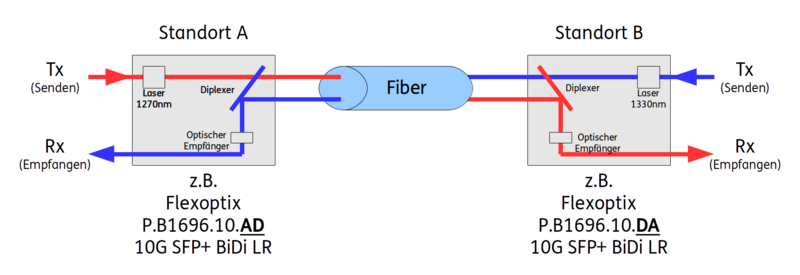BiDi Transceiver
BiDi transceivers (bidirectional transceivers) enable full-duplex data transmission via a single optical fiber. The data transmission from A to B (sending) takes place on a different wavelength than on the return path from B to A (receiving). Why two different BiDi transceivers always have to be used in pairs for a data line is explained in this Wiki article.
Area of application
BiDi transceivers are used in the following areas:
- Fiber optic Internet connections such as FFTO (fiber-to-the-office) and FTTH (fiber-to-the-home).
- Interconnection of data centers / Metropolitan Area Networks (MAN)
How it works
Two different BiDi transceivers are used in pairs for each connection:
- The first transceiver transmits data at wavelength A (1270nm in this example) and receives data at wavelength B (1330nm in the example).
- The second transceiver transmits data at wavelength B (1330nm in this example) and receives data at wavelength B (1270nm in this example).
The following figure illustrates how this works:
Advantages
BiDi transceivers provide the following advantages for networking between buildings:
- Double network capacity: each fiber strand can be fully utilized. For example, if a cable with 6 strands is available, six connections can be established with BiDi instead of three with conventional transceivers.
- Higher reliability: Single strand solutions are less prone to link failures due to the reduced number of links and endpoints.
- Lower cost: By halving the number of fiber strands, the number of patch cords and patch panel connections can be reduced. In addition, less space is required for fiber management.
Versions
Singlemode BiDi transceivers are available for:
- Different form factors: SFP - 1Gbit, SFP+ - 10 GBit, SFP28 - 25 GBit, QSFP28 - 100 Gbit
- Different ranges:
- SR <1km (short reach)
- LR 10km (long reach)
- LR 20km
- ER 40km (extended reach)
- ZR 60km
- ZR 80km
- Different temperature ranges:
- Normal: 0 - 70°C
- Industrial: -40°C - 85°C
|
Author: Werner Fischer Werner Fischer, working in the Knowledge Transfer team at Thomas-Krenn, completed his studies of Computer and Media Security at FH Hagenberg in Austria. He is a regular speaker at many conferences like LinuxTag, OSMC, OSDC, LinuxCon, and author for various IT magazines. In his spare time he enjoys playing the piano and training for a good result at the annual Linz marathon relay.
|


